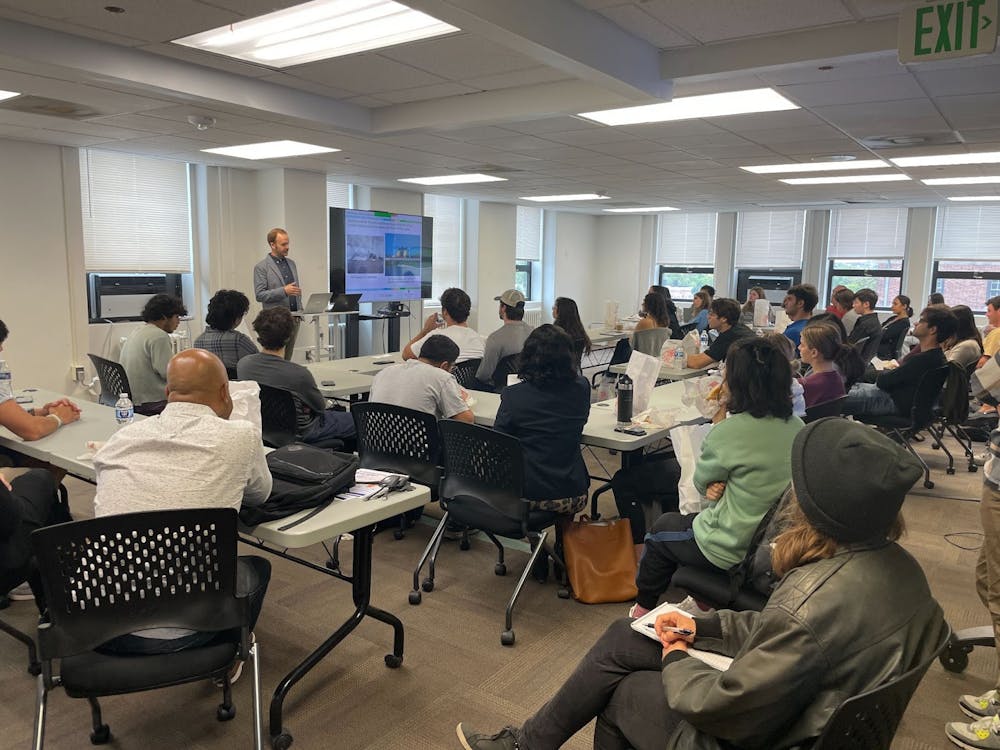The Economic Policy Issues Colloquium (E.P.I.C.) held an event titled “From Burning Harbors to Basement Backups: Urban Pollution and Local Economic Development in Baltimore” on Sept. 29.
The event was led by Mac McComas, the senior program manager of the 21st Century Cities Initiative at Hopkins. Within the initiative, McComas is the project manager of the Baltimore Social-Environmental Collaborative, which partners with disinvested Baltimore neighborhoods to research equitable pathways concerning climate change adaptation and mitigation.
In an email to The News-Letter, Hellen Seshie-Nasser, co-faculty advisor of E.P.I.C., explained that the talk aims to engage students in topics of economic development and environmental pollution.
“Each semester, [E.P.I.C.] asks economics students what they are most passionate about. Environmental policy is always uppermost on the list,” she wrote. “It is important to realize that we need to understand economic development and environmental pollution in our local communities as well as at the national level.”
Freshman Luca Geiger explained why he attended the event in an interview with The News-Letter.
“I’m interested in environmental issues related to water quality, pollution and urban water management, coming from Los Angeles, [Calif.], which experiences similar issues as Baltimore,” he said.
In the context of a recent outbreak of Cryptosporidium, a naturally occurring bacteria, in two reservoirs of Baltimore City and an E. coli outbreak in West Baltimore earlier last year, the discussion centered around water pollution. McComas prompted the attendees to consider a series of questions on assessing public versus private goods and services, financing green infrastructure in the city and resolving conflict associated with green gentrification and border freeriding.
McComas mentioned a classical problem in urban economics — the negative externalities of people living in close proximity.
“There are a lot of good things about cities in terms of bringing people close together, helping facilitate trade services, social interactions and innovations,” he said. “But there are also negative effects to people clustering together.”
Considering the significant increase in Baltimore’s population since 1800, McComas discussed the associated public health issues and how that led to the integration of separate sewage and stormwater systems and subsequent infrastructure improvements. However, 100 years later, these upgrades proved inadequate.
“The history of the city is largely industrial, which leads to a long history of waste, neglect and environmental degradation,” he said.
The city is trying to resolve issues of water management through the U.S. Environmental Protection Agency (U.S. EPA) to balance green and gray infrastructure. According to the speaker, a regional water governance task force has also also formed to provide public recommendations.
“Since 2002, the city [has] spent approximately $800 million to upgrade the water system,” McComas remarked.
This also relates to advocacy among local groups such as Blue Water Baltimore, many of which challenged some of the current city initiatives such as street sweeping over long-term infrastructure investments. Similarly, private businesses have tried to support the cause. One example is the Healthy Harbor Initiative with the goal to make Baltimore Harbor swimmable and fishable.
Moreover, border issues exist with Baltimore County’s Urban Rural Demarcation Line, which determines the reach of public sewer and stormwater infrastructure. This line limits the type and density of development in areas beyond the line. Baltimore City is nested in Baltimore County and so water issues are intimately connected.
In an interview with The News-Letter, junior Riley Gist shared her perspective on the subject of the event.
“Having lived in Baltimore in the past three years, the city definitely gets a bad [reputation], but I felt the [discussion] really shed light on all the positive efforts going on in the city, and I found that to be valuable,” she said.
Baltimore is not unique in its sanitary sewer overflows. McComas suggested looking at neighboring city policies as a reference, noting that Philadelphia and D.C. are also under EPA consent decrees to handle similar issues.
“Green City Clean Waters, a program in Philadelphia, built a kind of distributed public and private system of green infrastructure through things like rain barrels, rain gardens and other kinds of water detention infrastructure which has been heralded as a major success,” he said.
Gist expressed interest in learning more about infrastructure improvements and remediation efforts beyond the presentation.
“After this [presentation], I am definitely enlightened to learn what is going on in the city through grassroots organizations and research efforts to improve the quality of life here. Just knowing these things [are] in place does give me a positive outlook,” she said.





